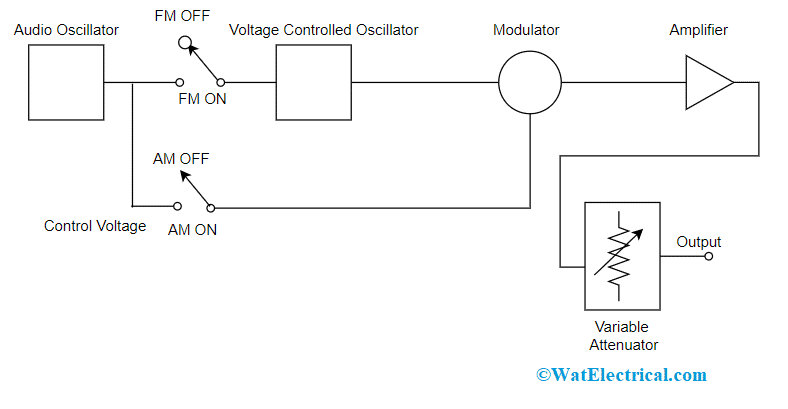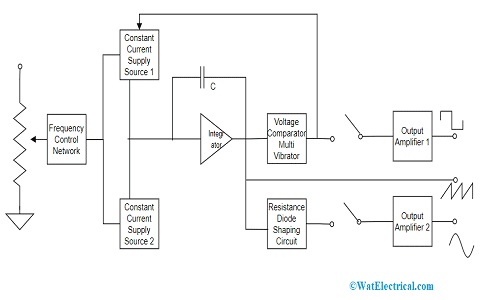The initial and commercial type of signal generator was invented in the year 1928 where it supports a frequency range of 500Hz – 1.5 MHz and in April 1929. The initial commercial frequency standard type signal generated was promoted by General Radio with a supporting frequency of 50 kHz. Coming to the first application of this device, an HP 200B audio kind oscillator was used for the calibration of Disney’s breakthrough stereo sound systems that were established in cinemas. But, what exactly a signal generator is? This article explains its concepts along with its features, purpose, and types to know this in detail.
What is a Signal Generator?
A signal generator is an analog or digital type electronic test device that generates accurately standardized signals which have the frequency range from audio to microwave. These delivered signals can be modified based on impedance, modulation, frequency, waveform, and output voltage.
Purpose
The signal generator purpose and its importance are explained below:
At the time of testing designs, there has to be accuracy in the measurements, so when a signal generator provides output as sinewave then the delivered output has to be almost ideal. Whereas when the output is non-ideal, it leads to extended levels of harmonics, distortion, phase noise, and spurs which ultimately hides signals those are low level. So, when a signal generator is used it provides a sinewave that is almost ideal and has no distortion levels, noise, and spurs.
The signal generator device holds the ability to deliver complicated signals even from the single and integrated device without the use of any additional hardware components. When operated along with high-end software, then complicated signals like OFDM can also be delivered through a single and highly operated signal generator having high-level fidelity.
Also, the device holds more prominence because it can generate more precise power levels which is the most required feature in power amplifiers, attenuator testings, and filtering.
Block Diagram of Signal Generator
In the block diagram, the most essential component is the voltage-controlled oscillator (VCO) where its frequency is used for the determination of the level of input controlling voltage. The level of VCO frequency is directly related to the level of controlling voltage. The signal which is applied to the controlling input provides the oscillator’s frequency. The VCO provides an FM signal only when there is the application of an audio input signal for the controlling voltage device.

Signal Generator Block Diagram
The device also generates other model waveforms like arbitrary, digital, an+d tone. Along with modulated output signal, the device generates an additional signal where this is the main variation between an oscillator and a signal generator. These modulated signals can be in the pattern of either triangular, square, and other complex patterns.
In the case of frequency modulation, the VCO is placed just before the modular circuit. The circuit modifies the level of VCO output voltage by generating the output AM signal.
And the signal generator circuit is shown below.

Circuit Diagram
In determining any damaged part of the electric circuit, a signal tracing method is implemented where this approach is mainly used in audio electronics for finding defects. This approach can be implemented by adding a signal source at one terminal and the output is identified at other terminals. The circuit is designed using a capacitor and resistor which forms a simple oscillator.
Types of Signal Generator
There exist various kinds of signal generators having assorted characteristics and applications. Below are a few types of signal generators explaining the unique capabilities of each type.
Functional Type Generators
This includes an electronic component termed an electronic oscillator where produces continuous signals like square, sawtooth, sine, and triangle signals. In the modern type of electronic device, these signals are formed using the DSP method using analog signals having minimal frequency levels.

Functional Type Signal Generator
Arbitrary Type Generators
These are devices that deliver the arbitrary flow of digital data. The delivered waveforms do not possess any constant shape, and these can be entered into many other waveform types. This type of generator has two separate output channels which are used for the stimulation of two systems concurrently.
The main use of arbitrary generators is for system stimulation with a complicated waveform. This consists of a display screen where it displays the exact waveform so that it eliminates any kind of mistakes that might happen while selecting waveforms from memory. Also, these have restricted bandwidth levels and prices higher than the functional types of signal generators.
RF Type Generators
This radio frequency type signal generator uses a variety of approaches to generate PLL and direct signal synthesis signals and many others. But many of the devices utilize the PLL method where this technique can provide enhanced precision and stability as needed by the system. The output is within its frequency range, and it generates CW signals. The characteristics of microwave and RF-type generators are almost similar except they vary in their frequency ranges.
Audio Type Generators
These devices provide signals having an audio frequency range that is in the range of 20 Hz to 20 kHz. The main usage of the audio signal generators is in testing the frequency response of audio systems and in distortion calculations. These devices are capable of verifying even minimal distortions which can be calculated through a simple circuit. These have very minimal harmonic distortion levels.
Video Type Generators
A video type of signal generator generates video waveforms. In addition to this, few other signals are also utilized for the stimulation of deficiencies. The crucial aspect that shows the impact on video images is synchronization. Because of this, the generated output of video generators consists of synchronization signals having both horizontal and vertical sync.
Formats
In the same way as other testing devices, signal generators are also available in different formats. These formats are based on the corresponding kind of generator and also there are multiple options available such as instrument card for rack verification, bench verification instrument, USB dependent signal generator, and utilize the signal which is generated.
Along with this, there are also other types of signal generators like analog, logical, and others.
Characteristics of Signal Generator
While choosing the correct type of signal generator, it is more critical to select corresponding specifications as per requirement.
These specifications are classified mainly as amplitude, spectral purity, and frequency.
In frequency specifications, resolution, switching speed, accuracy, and range are the main factors.
- Range states about the range of output frequency levels.
- The resolution identifies the minimal frequency level increment of the source
- Accuracy identifies how close together is the source output frequency is to the set level of frequency.
- Switching speed states how quickly the output reaches the updated frequency level and this is the main factor in determining the cost of the device.
In amplitude specifications, resolution, level of dynamic range, switching speed, and accuracy are the crucial factors.
- Dynamic range identifies the variation between the maximum and minimum levels of output power ability.
- The resolution specifies the minimal feasible amplitude increment.
- Switching speed calculates how quickly the source varies from one amplitude level to another level.
The main factors are spurious, level of phase noise, and harmonics in the spectral purity characteristics.
Uses
The main uses of the signal generator are as follows:
- The device is used for testing and high-end design purposes
- Used for components verification, testing of systems and in receivers
- Extensively applied in the applications of cellular communications, audio and video broadcasting, WiFi, radar, geo-positioning satellite, and in many other applications.
know more about Function Generator.
This is the overview of the signal generator. This article focuses on the signal generator block diagram, circuit, types, characteristics, and applications. Also, know, what are the drawbacks of a signal generator and how do these downsides show the impact on the device performance?